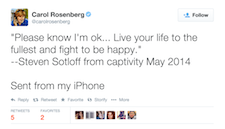This story originally ran on Saturday, Sept. 13, in the Miami Herald. It has been reposted with permission. Carol Rosenberg will be featured Tuesday night on @muckrack’s #MuckedUp chat.
When I report from Guantánamo for the Miami Herald, I routinely use Twitter to report war court proceedings, play by play, like a sporting event, as one of my editors described it.
I sit in a filing center, pay $150 a week to hook up to the Internet and watch the court on a closed-circuit feed. I go to Guantánamo because it is there that I can talk to the lawyers and the prosecutors to write a more granular story. There, I talk to the victims’ family members, talk to the experts. And the reason I tweet is that it’s a court where people can’t reach, and I learned that lots of people want to know what’s going on there moment to moment — who’s testifying, what’s the legal principle at issue, what are the accused terrorists doing.
But I was still taken aback, horrified, sickened, recently when our social media czar assigned me me to “tweet quotes” from the funeral of Steven Sotloff, the no-photography Jewish religious service for the South Florida journalist who was beheaded by the Islamic State: Inside the synagogue. Among worshiping mourners. Where people around me might consider using an iPhone in bad taste.
My experience in synagogues is, they tell you to turn your cell phones off. Sitting with a notebook in your lap quietly taking notes is one thing; tweeting away is another.
But I was wrong. First of all, the police restricted reporters to a separate portion of the sanctuary. It was like traveling to the war court proceedings. We sat in the back. And I was handed a note that made clear that photography was strictly forbidden.
But what about the taste test? What about the idea that it would be rude, an etiquette breach or disrespectful to the family to tweet a religious funeral ceremony?
I asked. Neither the Miami-Dade police who sat in the media section nor the synagogue security officials thought that way.
“Have at it!” said one enthusiastic cop who was wearing a badge but not a skullcap.
So it was with some trepidation that I announced before the ceremony began that I was going to be reporting my first Twitter funeral. With permission.
At one point, I asked the cops whether I could tweet a picture of a handout to worshipers: The lyrics to the Pink Floyd song Wish You Were Here, distributed by the Sotloff family. Sure, they told me, just step outside.
The service began with a significant number of empty seats. And I was torn. Do I really want to tweet that? That’s what journalists do. They point those things out. They describe the scene. Like this: “Steven Sotloff service begun. Pin-drop silent as family enters sanctuary, takes seats.”
I decided to wait. And this being South Florida, enough stragglers trickled in to make the empty seats less conspicuous.
Then there’s the issue of context. The 140-character limit doesn’t really leave room for that. One editor instructed me to just tweet “quotes.” So I did just that when a cousin read letters smuggled out of Sotloff’s Islamic State captivity, an eerie voice from the grave that really deserved context, which it got in the Miami Herald article I wrote later that day.
To be sure, there was a bit of a backlash. One follower dropped me.
And another Twitter user named largebill68 called me out. “@carolrosenberg Is media so ghoulish they actually tweet from memorial? As bad as that moron taking selfies at Mandela’s mem.”
I had tweeted the explanation for why I would be doing it to try to mute the likely criticism.
And in the end, I discovered for this particular funeral, that of a freelance journalist, there was a Twitter audience out there who wanted to follow along. Just like my Guantánamo war court followers, they wanted to see through words a place where they could not be.
Not as voyeurs, but perhaps to participate in the funeral even if just a bit. Virtually.
It was an interesting issue in terms of the taste test. I was worried it would be distasteful, rude in a religious setting. But I did my job and, if instructed to do it again in similar circumstances, I think I’d have the same questions.
What is tacky? What is disrespectful? Just because other news organizations do it, should mine? We never once considered posting the video of Sotloff’s execution. And I would expect nothing less.







Comments